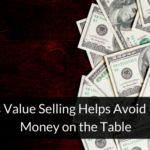In the economic downturn of 2008, Philip Lay, Todd Hewlin, and Geoffrey Moore wrote a thought leadership piece for Harvard Business Review (HBR) entitled, “In a Downturn, Provoke Your Customers.” I give them credit for setting off a chain reaction that we now know as “Selling Insight.”
Once again, we find ourselves in a severe downturn. We have moved from economic abundance to a time of financial scarcity with vast repercussions, many of which we can’t even comprehend yet as we figure out the “new normal.”
Buying Dynamics Have Shifted
Given the magnitude of our current situation, future generations will probably be talking about 2020 in 2120. Purse strings have tightened with hiring freezes, massive layoffs, and across-the-board cost-cutting. And business strategies are rapidly changing out of necessity. Organizations need lots of help to survive and thrive in these turbulent times, which create a much harder selling environment.
I do believe what once was old is new again. As the authors proposed in 2008, you have to provoke your buyers and bring them new insights. And before you can share those insights, you will have to work harder to land your selling conversations.
The answer is to focus on “Painfully Obvious Value!” in your selling conversations. If you want to close more business in this tough sales and marketing climate, you need to make it painfully obvious why they should care.
Who Are Your New Buyers?
Steve W. Martin introduced the concept of the “bully with the juice.” This is the one member of the buying team with the most power, confidence, and focus to determine which vendor is selected. Martin advised us to identify and focus on that person to win the business. Unfortunately, today your old buyers have been relegated to mere influencers.
I’d like to bring forward a notion of the “buyer with the juice,” or, the economic decision maker. In the past, this buyer created smaller “juice boxes” and gave them out to directors and managers in the form of “budgets.” They could spend that budget with minimal scrutiny, provided it fell within the realm of their “juice box” budget.
In the new reality, however, any money they spend will be scrutinized heavily by senior leadership – the buyers with the juice. If your old go-to buyer wants to minimize their career risk, they most certainly will be internally selling upwards to the buyers with the juice before any action is taken.
You can spend your time selling to lower level non-buyers, which used to work when lower levels of the organization were enabled with budget and decision making authority. Now, if you want to close more business in this tougher selling climate, you need to retarget and communicate directly with the buyer with the juice.
When there is a buyer shift, there needs to be a value proposition shift. This age-old principle still holds true: buyers define the value. It’s your job to help them see value in the right way.
What Is “Painfully Obvious Value” to Your New Buyers?
In the recent past, most marketers and sellers led buyers with aspirational value and discussions of “why” buyers should make the change. They focused on helping the buyer move from their current state to a desired future state, which led to “pleasure-centered” sales conversations and product demonstrations that emphasized the benefits of adding the product to the buyer’s world.
Today’s successful marketers and sellers gain buyer attention and close more deals by starting with the buyer’s problem: the costly “as is” problem as opposed to an aspirational “to be” problem. To make the most of your sales conversations, you need to double down in characterizing the buyer’s problem and the associated pain it is causing in operational, emotional, and financial terms. Then “pour gas” on the problem to get the buyer’s attention.
Your new executive-level buyers with the juice will typically evaluate their buying decisions along financial dimensions. Ultimately, they will ask themselves, “How much money will I save or make by making this change in my business?” This is where you have to sharpen your ability to quantify the magnitude of the buyer’s problem in financial terms, and show how much it’s costing them in dollars and cents. Then you need to help them wallow in their pain as they think about how much money is being wasted in terms of not being saved or not being made by letting the problem persist. This is the cost of delay.
This is the crux of the “painfully obvious value.” Once this is anchored to your buyer, you can move forward discussing how your solution can make that costly problem and associated pain go away and convey other associated benefits.
Conclusion
Are you ready to start building “painfully obvious value” into your value proposition? If so, I have curated several free assets you will find valuable as you rethink your value proposition and sell higher in the organization.

Resources
Connect with guest author Bruce Scheer on LinkedIn.
Join the Value Selling for B2B Marketing and Sales Leaders LinkedIn Group.
Visit the ROI Selling Resource Center.












